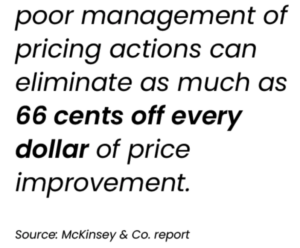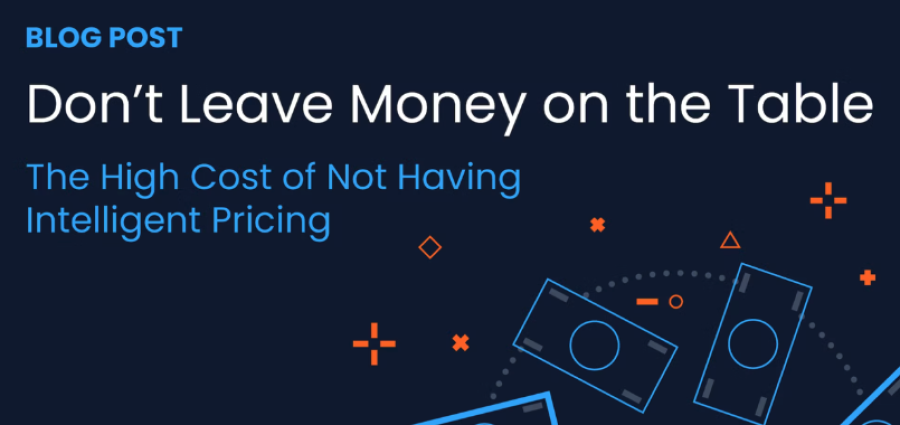With a tight economy, distributors must maximize their use of intelligent pricing to maintain the optimal market share mix to achieve the best combination of revenues and margin.
Intelligent pricing enables distributors to sell the right product at the right time at the right price to the right customers, enabling them to boost gross profits by 4 percent or more.
Basic pricing on products relies primarily on the law of supply and demand – high demand and low supply lead to higher prices, while prices drop when those factors are reversed – one has to look no further than the local gasoline service station to see the effect on pricing from supply changes when OPEC increases or decreases supply, or when there is a refinery outage or during the busy summer driving season.
Intelligent pricing takes the concept of supply and demand to the next level by factoring in several other elements that help determine what a specific customer is willing to pay for a product or service.
What is Intelligent Pricing?
Accenture defines intelligent pricing: “A tailored approach that determines willingness to pay based on multiple factors such as time of day, location, real-time demand for products, and even a customer’s purchasing history. It’s data-driven, not just rules-driven, using algorithms and customer intelligence to deliver instant pricing that is increasingly contextualized or even customized.”
With many economists predicting a pending recession and margins being squeezed throughout the supply chain, it’s more important than ever that distributors seek to maximize the prices that they can command for their products.
Failure to do so limits margins and profitability, but simply raising prices indiscriminately will lead to lower sales and margins. According to a McKinsey & Co. report, poor management of pricing actions can eliminate as much as 66 cents off every dollar of price improvement. Distributors need sophisticated, intelligent pricing to determine what prices customers will accept, the number of customers who may reduce their purchases as the result of any price increase, optimal discounts (if any) to attract new large purchases, and related factors to optimize revenues and margins, particularly in a tightening economy.

For distributors, pricing is the critical last mile of the go-to-market equation. Below are just a few of the opportunities that distributors can miss out on by failing to use intelligent pricing:
Keeping pace with higher input costs:
While some distributors seek to retain customers by absorbing their own increased costs rather than passing them along, such a practice can result in only temporary short-term gains while resulting in current margin compression and longer-term revenue losses.
While a distributor might be able to hold the line (and retain some customers) during a temporary spike in input costs, if costs continue to rise, the distributor, at some point, will be forced to boost prices by a much more significant percentage, causing “sticker shock” among their customers.
Intelligent pricing ensures that distributors maintain their margins while keeping customers as happy as possible.
Responding to customers’ immediate needs:
Customers that need products quickly will gladly pay the premium to receive goods when they need or want them rather than waiting. But the immediate need can change rapidly. A customer may be willing to pay more today to receive a product in a week — when they know they can quickly turn around and sell the product to their own customer. However, by the following week, that opportunity could be gone, so the customer may still purchase the product but will balk at any premium for faster delivery.
Intelligent pricing allows you to stay on top of it all, so turnaround time doesn’t mean you’re missing out on greater profits.
Improved operational visibility:
Distributors need insight into their inventory and supply chain. That means having insight into systems across what is often a disparate set of systems, including Customer Relationship Management (CRM), Business Intelligence (BI), and pricing systems. And that also includes the complete knowledge of pricing and profitability performance of sales reps, branches, product lines, and customers. This overarching visibility is necessary to uncover micro and macro trends to optimize pricing decisions.
Optimal customer segmentation: Different customers have different product and volume requirements. A large, diversified customer might buy products across several different categories at various times and be willing to make occasional bulk purchases in exchange for volume discounts.
Alternatively, a smaller customer may need more financial wherewithal to make large bulk purchases. The distributor must be able to recognize these differences and price products appropriately to maximize margins as well as to foster long-term customer relationships. Similarly, there are robust cross-sales opportunities with some customers but not with others.
Intelligent pricing, which includes using customer segmentation, helps distributors understand the opportunities by grouping customers according to their needs, requirements, and buying behavior.
Improved salesmanship:
While an increasing number of distributors’ sales are moving to e-commerce platforms with little or no human intervention, there are still numerous sales made with a salesperson involved in various parts of the sales funnel. The distributor must know which salesperson to put on which account(s) to maximize revenue. For optimum results, salespeople also need good product knowledge and the ability to have granular product information at their fingertips. Armed with a rich customer and product segmentation, market pricing, and benchmarking, sales reps can provide accurate quotes quickly and confidently.
Limitation of pricing overrides:
Many distributors have a sales culture of runaway cost overrides, which erodes revenue over time. While sometimes it is prudent to override initial pricing guidance to maintain a long-term customer relationship, distributors need to avoid a “race to the bottom,” in which they and competitors continue to cut prices to the point that margins are diminished without any long-term benefit. Having intelligent pricing in place can ensure that pricing is data-driven as opposed to emotional in nature.
With comprehensive pricing analytics and guidance from pricing experts, distributors can deploy best practices for pricing, enabling them to improve pricing decision-making at every point during the sales funnel for a data-driven sales strategy that maximizes revenues and profitability, as well as differentiation from competitors.
Related Posts
-
The quarterly Baird-MDM industrial distribution survey gauged distributors' confidence heading into 2023. Here's what they…
-
Strong underlying industrial demand continued throughout the quarter, but a slowdown may be ahead. Read…
-
We chat with Dee Merriwether, CFO of Grainger, which took the top spot on MDM’s…






